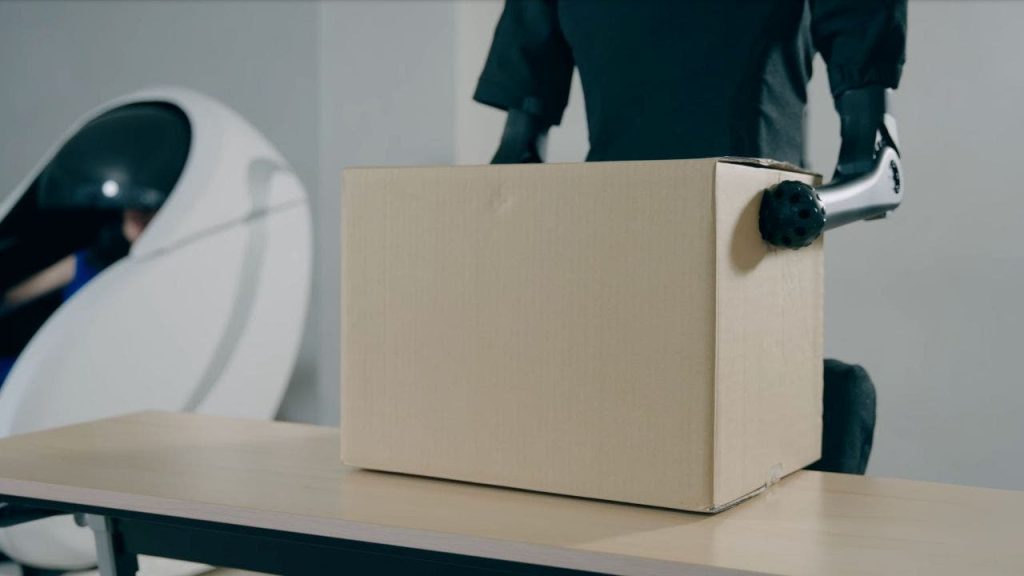NEWYou can now listen to articles!
H2L, a technology startup based in Tokyo, has unveiled the Capsule Interface, a pioneering device allowing users to control robots using their entire bodies. This innovative breakthrough transmits not only movement but also physical exertion, promising to redefine human-robot interactions. The Capsule Interface is expected to enhance the precision and immersion of operating robots and digital avatars, ultimately transforming various industries.
| Article Subheadings |
|---|
| 1) Advanced muscle displacement sensors: The heart of the Capsule Interface |
| 2) Seamless remote operation: Comfort meets control |
| 3) Real-world applications: From business to disaster response |
| 4) The future of body sharing: Expanding sensory feedback |
| 5) Kurt’s key takeaways |
Advanced muscle displacement sensors: The heart of the Capsule Interface
At the core of the Capsule Interface lies sophisticated muscle displacement sensors. These sensors set themselves apart from conventional teleoperation systems, which often depend solely on motion sensors or exoskeletons. Instead, H2L’s sensors are engineered to capture even the minutest changes in muscle tension, effectively detecting not just movement but the intent and effort accompanying each gesture.
When a user lifts, pushes, or grasps, the system evaluates the intensity of the force exerted and transmits this data to a remote robot in real-time. The outcome is a far more authentic, responsive, and natural interaction between humans and machines, enhancing the user experience significantly.
Seamless remote operation: Comfort meets control
The design of the Capsule Interface focuses heavily on comfort and ease of use. This device can seamlessly integrate into various settings, including chairs and beds, allowing for robot operation while seated or reclined. There’s no necessity for cumbersome wearables or extensive training regimes; users simply move their limbs, and the system immediately records and transmits these movements along with related muscle activity.
Equipped with a display and audio speakers, the Capsule Interface offers real-time audiovisual feedback, thereby establishing an intuitive and engaging two-way connection. This level of interaction fosters a user-friendly environment, making it accessible for individuals of all experience levels.
Real-world applications: From business to disaster response
The scope of the Capsule Interface’s application is extensive. In the business sector, professionals can participate in meetings or complete tasks remotely by operating humanoid robots from their homes or adjacent offices. Additionally, it can lighten the physical demands placed on delivery workers by enabling them to carry heavy items from afar, mitigating the risk of injury.
The technology’s potential extends beyond business into areas such as disaster response, allowing operators to control robots in dangerous environments without endangering human lives. Beyond these applications, the Capsule Interface can assist with daily tasks in homes, support elderly family members, and empower farmers in managing agricultural machinery remotely.
The future of body sharing: Expanding sensory feedback
H2L anticipates future developments that will further enhance the Capsule Interface, including the introduction of proprioceptive feedback. This revolutionary feature would not only permit users to control robots but also enable them to experience the sensations the robots perceive, such as resistance when lifting heavy objects or feeling the texture of items through the robotic interface.
Integrating this kind of tactile feedback will render the remote experience much more authentic, promoting naturalness in collaboration and communication. Such advancements could pave the way for innovations in fields ranging from education and healthcare to entertainment, where a genuine sense of touch could transform the user experience.
Kurt’s key takeaways
In conclusion, H2L’s Capsule Interface offers a glimpse into a future where our physical abilities can be significantly extended beyond the confines of our bodies. By enabling natural movements and facilitating the transmission of force sensations, this technology stands poised to alter the landscape of work, social interactions, and assistance across various domains.
| No. | Key Points |
|---|---|
| 1 | The Capsule Interface allows users to control robots with their entire bodies, enhancing interaction precision. |
| 2 | Sophisticated muscle displacement sensors capture minute changes in muscle tension. |
| 3 | The device provides comfort, integrating into existing furniture for seamless operation. |
| 4 | Real-world applications span from business settings to disaster response and daily life assistance. |
| 5 | Future updates aim to introduce tactile feedback for a more realistic interaction. |
Summary
The Capsule Interface by H2L signifies a substantial advancement in technology, pursuing to reshape how humans interact with robots through enhanced physical engagement. By merging precise control with sensory feedback, it has the potential not just to revolutionize robotics but also to transcend geographical limitations in communication and collaboration, promising significant implications across various sectors.
Frequently Asked Questions
Question: What makes the Capsule Interface unique?
The Capsule Interface’s unique aspect lies in its sophisticated muscle displacement sensors, which detect even the smallest muscle tensions, allowing users to transmit not just movement but also applied force to remote robots.
Question: How can the Capsule Interface improve business operations?
In a business context, the Capsule Interface allows remote participation in meetings and tasks without physical presence, enabling professionals to control humanoid robots and manage tasks from afar.
Question: What future features are planned for the Capsule Interface?
Future developments include proprioceptive feedback, which would allow users to feel what the robot is experiencing, thus enhancing the realism and effectiveness of remote interactions.


